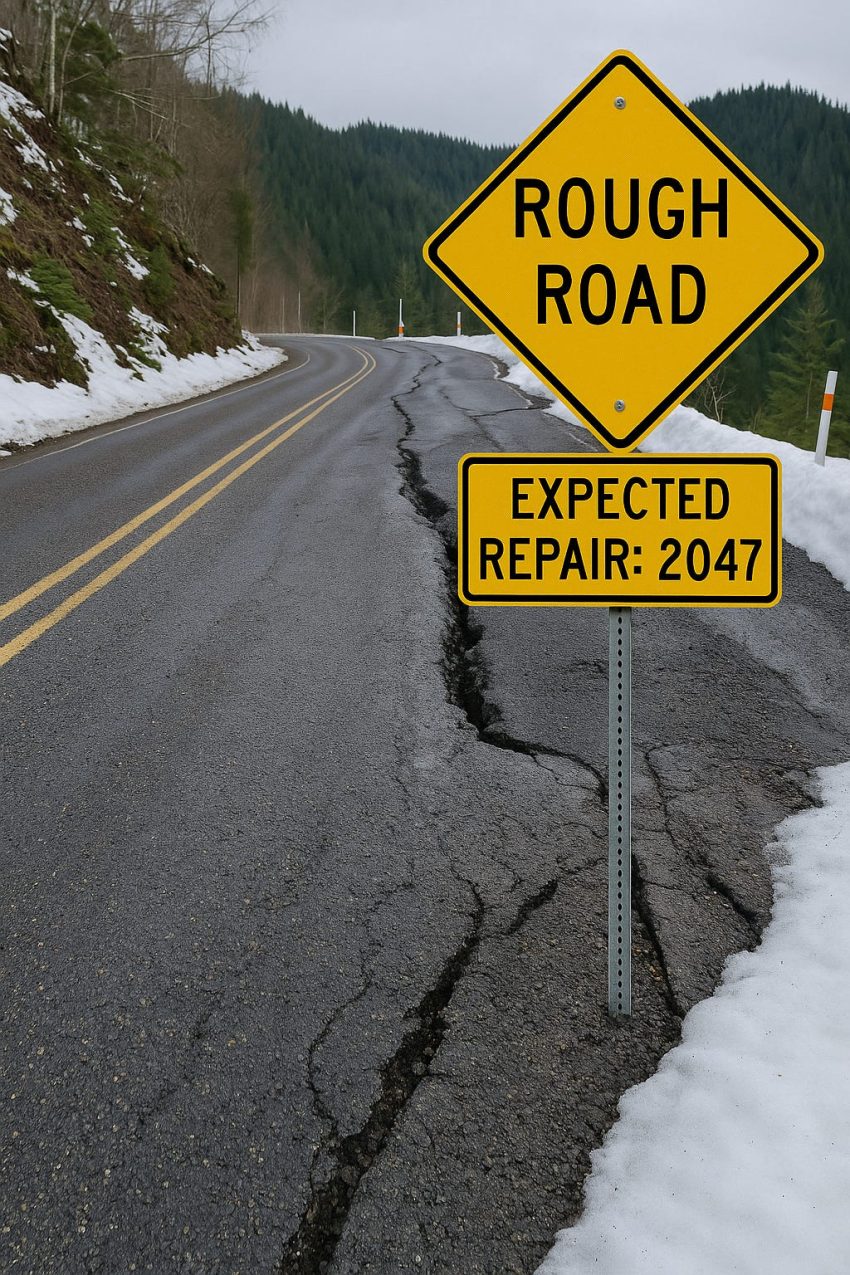 EDITOR’S NOTE: Here’s an installment from Tillamook County’s State Representative Cyrus Javadi’s Substack blog, “A Point of Personal Privilege” Oregon legislator and local dentist. Representing District 32, a focus on practical policies and community well-being. This space offers insights on state issues, reflections on leadership, and stories from the Oregon coast, fostering thoughtful dialogue. Posted on Substack, 5/13/25
EDITOR’S NOTE: Here’s an installment from Tillamook County’s State Representative Cyrus Javadi’s Substack blog, “A Point of Personal Privilege” Oregon legislator and local dentist. Representing District 32, a focus on practical policies and community well-being. This space offers insights on state issues, reflections on leadership, and stories from the Oregon coast, fostering thoughtful dialogue. Posted on Substack, 5/13/25
Fixing Roads, One Committee at a Time (Please Allow 10–15 Years)
So you call the state. “Hey, just a heads-up—the highway is about to become a waterslide.” They thank you, take notes, and immediately launch a process that involves three feasibility studies, a wildlife corridor review, and a salmon sensitivity analysis.
Before anyone so much as lifts a shovel, you’re pulled into the bureaucratic afterlife—a purgatory of forms, forums, advisory councils, and acronyms. It’s not that the government won’t help. It’s that the government must first confirm, in triplicate, that helping is legally distinct from interfering with moss.
You don’t need to believe in deep-state conspiracies to think the system’s rigged against you. You just need to try fixing a road and live long enough to watch it not happen.
The Cult of Process
Picture this: You live in a small coastal town in Oregon. Two major highways—Highway 6 and Highway 26—are your arteries to the rest of the state. They’re not glorified dirt roads for off-roading enthusiasts. They’re major thoroughfares that families drive to get kids to school, tourists travel for beach getaways, and truckers rely on to keep local businesses alive.
And these highways? They’re crumbling. Not just a few pesky potholes here and there. Whole sections are sliding off the edge of cliffs into the watery abyss below, like something out of a doomsday movie starring Dwayne “The Rock” Johnson.
By any reasonable standard, this should be priority number one for government agencies. We’re not dealing with a decorative mural or a dog park. We’re talking about life-and-death, connect-our-community kind of infrastructure. And yet, you might be forgiven for thinking the powers that be are waiting for the entire highway to plummet into the river before they actually fix it.
A Thousand Steps to Nowhere
Now, let’s be clear: This isn’t about Republicans, Democrats, or the Starbucks aficionado who wears Birkenstocks to county board meetings. You can be a hardcore environmentalist hugging redwoods in your spare time or a free-market zealot who thinks taxation is theft—and you’ll still get smacked in the face by the same monstrous trifecta: regulation, consultation, and delay.
The unfortunate reality is that nobody can simply go out and repair a stretch of road—or fix a broken culvert, or rebuild a bridge—without wading through a labyrinth of red tape. There’s this polite fiction that we have “process” to ensure accountability and safeguard the environment. But somewhere along the line, the process itself became the objective. It’s like we’ve replaced the final exam with endless pop quizzes that never add up to a real grade.
Consider your average culvert replacement. The first step? An environmental impact study that determines whether these culverts are doubling as Airbnb rentals for migratory newts. If you discover said amphibians, you may need an additional hydrological variance assessment. Then, you’re required to hold three public comment periods, which basically means your fix is now delayed by at least two or three fiscal quarters—at best. If you’re unlucky (meaning you are 99% of the time), you’ll need to consult so many boards, commissions, and committees that your grandkids might be the ones finally cutting the ribbon on that new culvert.
Accountable to Everyone, Responsible to No One
Bureaucratic bloat isn’t exactly a fresh horror. We’ve had it simmering in the background ever since the mid-20th century expansion of federal agencies. Then came Watergate, and the mania for “transparency” and “reforms” added a thousand new layers of oversight to ensure nothing shady ever happens again. Each scandal, lawsuit, and political compromise stacked on more rules, more forms, and more caution.
The end result is something akin to Frankenstein’s monster. Even the well-intentioned folks toiling away in public service can’t move without checking a million boxes first. The do-gooders who try to cut through the Gordian knot get slapped on the wrist—or worse. Nobody wants to be the guy who made a common-sense move and landed the agency in a lawsuit because, well, you forgot to file Form XYZ in triplicate.
So these roads—crumbling highways that thousands rely on—sit in disrepair because the system is designed to move slower than a snail with two sprained ankles. Meanwhile, local officials wring their hands and say, “We’ve started the feasibility study for the feasibility study, so hey, progress!”
Three Ways Out of the Muck
Now, I’m not trying to sell you cynicism for cynicism’s sake. Despite my occasional flourish of exasperation, this is intended as a rescue mission, not a eulogy. We can fix this. But it requires us to look beyond the standard red-tape apologias and take meaningful steps to strip away the bloat.
- Default to Action: Give local leaders the authority to respond to pressing infrastructure failures with urgency, especially when a community’s well-being is at stake. If a highway is about to break off into the Pacific, that might qualify as a “just do it now” scenario. Let local municipalities initiate emergency repairs without a thousand prerequisite steps—and then let them justify it after the fact, if need be.
- Sunset the Red Tape: Every permit, every committee, every review board should come with an expiration date. If it’s still truly useful, it’ll be renewed. If nobody can make a compelling case for its continued existence, let it vanish into the regulatory ether. Because sometimes we keep these formalities around simply because they’re already there, like that dusty treadmill in your basement.
- Reward Results, Not Compliance: Shift the culture inside government agencies so that good work is applauded, not automatically suspect. If a public works employee finds a way to quickly patch a dangerous pothole without harming the environment, they should get a medal, not a pink slip. We need fewer bureaucratic gatekeepers and more people empowered to fix stuff.
Conclusion: Send the Plumber, Not the Panel
When your basement is flooding, the last thing you need is a 200-page manual on the plumber’s obligations for safe wrench handling. You need the plumber to walk in, fix the pipe, and dry out the floors. If he tells you, “Hang on, I’d love to help, but there’s a mandatory 90-day period for public feedback on the new pipe specs,” you’re not going to nod politely. You’re going to find someone else.
Government doesn’t get that existential jolt. There’s no competitor waiting in the wings to provide a better service if the state DOT doesn’t do its job. Instead, we’re stuck with the system, even if the system is about as efficient as trying to drain a flood with a teaspoon.
Now, no one’s asking for magic bullets here. We’re just asking for a process that moves at the speed of real problems, not the speed of red tape. It’s not that we need to tear up all rules or abandon environmental safeguards. We just need to ensure that they don’t become speed bumps that turn into roadblocks that turn into multi-year traffic jams.
At the end of the day, roads are more than just slabs of asphalt—they’re lifelines for families trying to get kids to school, small businesses hoping to stay afloat, and the broader community that needs to feel connected to the rest of the world. When those roads crumble, or when a simple sidewalk request drags on for eons, folks lose faith in the entire enterprise of governance. And who could blame them?
If we want people to stop feeling like they need conspiracy theories to explain government dysfunction, then we need to empower the folks who can fix these problems—and stop worshipping at the altar of “process” for the sake of process. Let’s reward the doers, not the filers. Let’s trust that, occasionally, local officials really do know what’s best for their community.
When the plumber shows up and stops the flood, we don’t ask him to fill out a novel-sized stack of paperwork explaining how he heroically tightened the bolt. We just say, “Thank you, and please send the bill.” Maybe, just maybe, that’s a model worth adopting for our highways, our bridges, and, yes, even our sidewalks. And if we manage that, who knows—maybe we’ll shave a couple of decades off those 2047 project completion dates.


